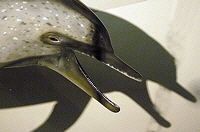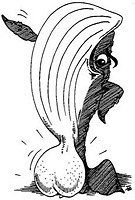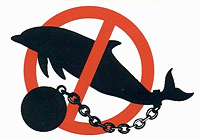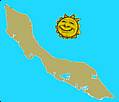

tourism

Isla oil refinery

"Dutch", owner of the Seaquarium, thought it a great idea to drum up some more business by opening an annex, the Dolphinarium or Dolphin Academy. Even though the Netherlands Antilles has signed the CITES convention, our government, just like that, decided to let him have his fun as this would attract (you'll never guess!) more tourists. What's CITES but marks on paper! (One of the dolphins died within a very short time).
In St. Maarten, by June 2005 they thought having adolfinariumof their own was a good idea; when protests came in, the government just did think it fit to release the documents concerning this.
Finally, in September 2005, the Antillean Government released a statement to the effect that a permit to open a St. Maarten Dolphinarium would not be forthcoming. What will happen when, in 2007, St. Maarten gets to be an autonomous island remains to be seen. They seem determined to go ahead.
Aruba Dolphins
De Palm Eiland, a new Aruba tourist trap, wants to have their dolphins as well (by 2009). This was too much to stomach for original Flipper trainer Richard O'Barry, who is now involved in training dolphins to release them to freedom. He says, in a letter to Amigoe newspaper,capturing and breeding dolphins for public display [is] simply wrong. If the paying public knew the truth about the capture, captive breeding and training of dolphins, they would revolt against it. In other words: They wouldn't buy a ticket.The new dolphin facility is an extension of the one on Curaçao, and they hastily organised a press conference where they kept assuring everything was just fine:We are not talking about animals in captivity or in freedom, we are talking about trained animals who are used to the presence of humans.
cute dolphin from South AfricaAutistic children at the Dolphin Academy
One of Dutchie's PR stunts. Autistic children are supposed to improve by contact with dolphins, and so, they will be flown over from Holland for a stay here. I don't begrudge the poor kids the trip, but am not so sure at all this will result in improvement of their autistic condition. My main concern is for parents who, once again, get false hopes raised. Reading various comments, one gets very skeptical indeed about this form oftreatment. The children might as well be sent to Lourdes or pray for them - ask the good lord to please remove the condition he saddled the kids up with in the first place.
[...] Up to 10 percent of parents have paid to have their children go horseback riding, swim in a pool with dolphins or receive healing touch therapy. [There is no] evidence that any of these alternative treatments improves the core symptoms of autism [...]There's a grief response to a diagnosis of autism; parents go through mourning and denial, and promising them their child will be cured by these therapies gives them false hope and only prolongs the grief,said Dr. Siegel of U.C.S.F.
Autism Therapies Still a Mystery, but Parents Take a Leap of Faith, New York Times 27 December 2004. And to quote NYTimes on June 5, 2006:dramatic improvement is what too many parents are led to expect, while in realityrecovery is extremely rare.
Dolphin Dutchie announced yet another educational project in October 2005. All primary school children are invited at the 'Academy' to come study the sea around us, and especially the dolphins that aren't there any more but held prisoner at the Seaquarium. It's only ANG500/kid; local entrepeneurs are cordially invited to sponsor. This is more or less run by the SamSam foundation, who also enable Curaçao children who are autistic or have Down's syndrome to come swim with the dolphins. They claim a high succes rate.
Doc Dolphin formed a link between Dutch autistic children anddolphin therapy.Even though they are still mentioned, their own website has disappeared.
Without trying to put these maybe well-meaning people down, this seems an extremely doubtful matter. In a short phone call with a representative, she informed me that care was taken not to select children with brain damage etcetera for this; only those with behavioral problems who run a good chance of benefiting. However, their web site explicitly states that they do send children with chromosome disorders, permanent brain damages etc. They also do not seem to link autism with a brain disorder per se, but it seems obvious that, vague as the term 'autism' is, in many cases there is a brain disorder involved. This seems to get more and more probable as time goes by. It looks a very remote possibility that a physical problem can be cured by spending a number of hours with these dumb fauna. Doc Dolphin may claim a good rate of success (but how good exactly? they gave me no figures when I inquired) for 125 children in one year, as confirmed in two follow-up visits to atherapist— one immediately after the therapy and one three months later. Not all (how many?) parents cooperate (why not?) It is hard to come to a conclusion based on these meagre facts, especially a positive conclusion.
A therapy costs €2750 per child; it is not clear if this includes flight to Curaçao and other expenses.
Is Animal Assisted Therapy Really the Cat's Meow? Probably the most extensively researched AAT is dolphin-assisted therapy (DAT), which is most commonly used for children with autism or other developmental disabilities. DAT is practiced not only in the U.S.—primarily in Florida and Hawaiï—but also in Mexico, Israel, Russia, Japan, China and the Bahamas, among other countries. Typically during DAT sessions children interact with a captive dolphin in the water while performing rudimentary manual tasks, such as placing rings on a peg. In many cases, the dolphin presumably serves as a "reinforcer" for appropriate child behaviors. Many DAT Web sites advance strong claims regarding this treatment's effectiveness; one asserts that "this field of medicine has shown extraordinary results of the therapy [DAT] and breakthroughs in outcomes" as compared with conventional treatments, including medication and therapy. Do the data support these assertions?
Emory University psychologist Lori Marino and one of us (Lilienfeld) have examined the research findings regarding DAT in two reviews, one published in 1998 and the second in 2007. We found the evidence lacking for DAT's effectiveness. In many cases, researchers had shown only that children who received DAT displayed improvements on some psychological measures as compared with children who did not. Yet such results do not exclude the possibility that these changes would have occurred with the mere passage of time. In still other cases, researchers did not rule out the possibility that reported improvements were merely short-term mood effects rather than lasting changes in symptoms. Finally, no researcher adequately excluded the possibility that the observed effects could have been produced by any animal or, for that matter, by any highly pleasurable stimulus. The research literature for other AATs appears to be no more definitive.Scientific American, June 2008 Lourdes-at-Sea In July 2007, a 19-year old girl from Brabant, Holland was sent to the dolphinarium by her co-villagers. She'd had a traffic accident two years before, which made her apermanent invalid.It was hoped swimming the dolphins would cure her. Now that would be a real miracle. Costs some €11,000.
Nothing more was heard about this; which would be yet another miracle if it had been successful.
Also check out Dolphins Are Aholes".
Then, there are plenty of dolphin rape-films around on YouTube. Might as well start here.
Those cute dolphins...
In April 2007, when a father tried to protect a child that was attacked by a dolphinarium inmate, he was attacked in turn and judged 'lucky to escape' with some scratches and bruises. Of course, the child and her father were blamed: You should only stroke a dolphin with your flat hand, and she scratched him with her nails. And naturally the dolphin resented that father attacking him! Agreed, naturally. So, better watch your step when around those dears.
Watch the video! The government had a commission look into this. It was all a regrettable misunderstanding and, as it turned out, the dolphins had apologized like hell after the mishaps (there were two.) Watch your stroke!
Around the beginning of 2008, a dolphin suddenly attacked people playing with him.
All videotapes and cameras were immediately taken away from their rightful owners
by those friendly Seaquarium guards.
Here's one that got out.
We are still waiting for the results of the investigation started by governor Goedgedrag. Experts do not accept the committee's conclusions that CITES and SPAW treaties have not been breached. They also maintain that such 'accidents' by dolphins misjudging jumps are impossible and must have been on purpose.
Mahatma Gandhi once said: "The greatness of a nation and its moral progress can be judged by how their animals are treated."
Dolphins can and do attack humans both in captivity and in the wild. There are many examples on the Internet. Google 'accidents and injuries from dolphin attacks' and find many websites that the dolphin industry does not want the public to see. Many attacks are not even reported.
Meanwhile, in Aruba a movement was started to free the dolphins.
One result has been that De Palm island has refrained from starting their own Dolphinarium there.
Even if they are rather more sentimental about it than I am,
I wholeheartedly concur. Set the bastards free! Alas, their site's gone.
Save Japan Dolphins Coalition has offered help in "repatriating" the dolphins;
the Dutch "Party for Animals" (really) has been interrogating Gerda Verburg of Landbouw en Natuur [agriculture and nature]
calling for an end to
DAT: Dolphin Assisted Therapy
read two of their PDF info brochures:
DAT leaflet
Can You Put Your Faith in DAT
Dumb Dolphins I have since read Paul Manger's (brain evolution scientist at Johannesburg's University of the Witwatersrand, South Africa) claims that dolphins, whales and porpoises may have super-sized brains but still are not smarter than a goldfish. Those circus tricks, he says, are much more a tribute to their trainers' skills than to the dolphins' smartness. Which makes those autism 'cures' still more suspect. On the other hand and in all fairness, who cares, then, about dolphins being locked up in Seaquarium cages? They're even too stupid to jump out! Well, I do.
Manger says the big brains of dolphins and their dumb buddies consist of very few ganglions and a seething mass of glia. While the ganglions make you smart, the glia just produce heat to keep the brains, such as they are, working in the cold water of the sea.
politics geography
climateeconomy
SEARCH this site or the Web

copyright notice
all material on this site, except where noted
copyright © by , curaçao
reproduction in any form for any purpose is prohibited
without prior consent in writing







